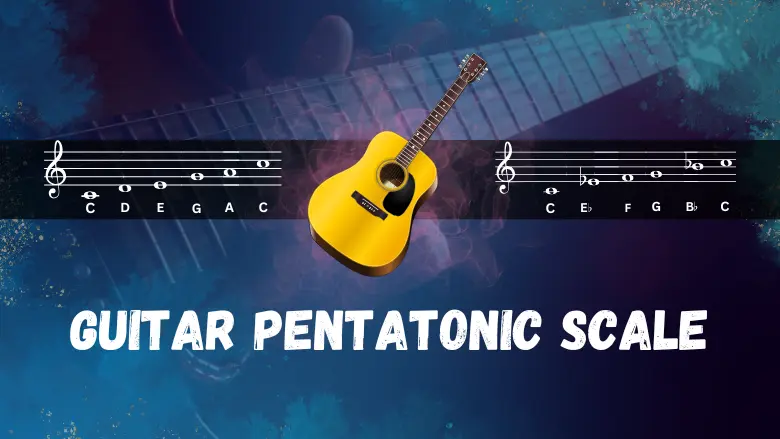- What is the pentatonic scale?
- Pentatonic scale formula
- Major pentatonic scale on guitar
- Minor pentatonic scale on guitar
- Best ways to play pentatonic scale
- Pentatonic scale for beginners
- Pentatonic scale guitar tips to improve your playing
- Pentatonic scale in different musical genres
- General mistakes in learning pentatonic scale shapes
- Pentatonic scale on piano
- Final thoughts
- FAQs
If you are a guitarist who has just started playing major and minor scales, learning guitar pentatonic scale will significantly improve your understanding of scales on guitar. Pentatonic scale is one of the most widely used scales in the music industry. When performing Rock, Blues, Jazz, or even Heavy metal, this scale is utilized as the foundation for innumerable amazing solos and melodies.
Many of your known bands like Led Zeppelin, AC/DC, Rolling Stones and Guns N’ Roses rely heavily on pentatonic scales. What the pentatonic scale is, how to play it, the formula that appears, and the various methods for mastering it on the guitar along with some pentatonic scale exercises all be covered in this blog.
What is the pentatonic scale?
It is a combination of 5 notes played in any scale (major/minor). It is a vital tool for guitarists because of its easy-to-play structure and smooth sound. The word pentatonic is derived from Greek words Penta that means five and tonic represent tones.
Pentatonic scales are combinations of 1st, 2nd, 3rd, 5th and 6th notes of the corresponding major scale. The minor pentatonic scale uses 1st flat 3rd, 4th, 5th and flat 7th notes.
This scale’s simplicity and melodic versatility make it popular in a variety of musical genres. Every guitarist should be familiar with the pentatonic scale patterns, which may be used for anything from contemporary Rock solos to traditional Blues licks.
Fun Fact
The “Safe” Scale: The pentatonic scale is popular for guitar solos and improvisation because it eliminates discordant notes, making it practically impossible to play a “bad” note!
Pentatonic scale formula
Major Pentatonic Scale Formula: 1 – 2 – 3 – 5 – 6
Minor Pentatonic Scale Formula: 1 – b3 – 4 – 5 – b7
These formulas dictate which notes you play and their positions on the fretboard. Understanding this formula is very helpful in mastering different scales in different keys all over the fretboard.
Major pentatonic scale on guitar
The major guitar pentatonic scale has a bright and happy sound. Here’s how it looks in different keys:
C major pentatonic scale
Notes: C – D – E – G – A
C major pentatonic scale is widely used in mainstream rock music, some of famous songs in C major pentatonic scale are Imagine by John Lennon, Let It Be by Beatles, Wonderful Tonight by Eric Clapton and Can’t Stop by Red Hot Chili Peppers.
G major pentatonic scale
Notes: G – A – B – D – E
The major guitar pentatonic scale shape is easy to learn and helps in creating smooth, melodic solos. Learning this scale shape is simple, and it facilitates the creation of melodic, fluid solos.
This scale is frequently used by guitarists to produce upbeat melodies in Rock, Jazz, and Country music. Songs like Sweet Home Alabama by Lynyrd Skynyrd (G major pentatonic), Here Comes the Sun by Beatles (A major Pentatonic scale) and Tears in Heaven (A Major Pentatonic).
Minor pentatonic scale on guitar
The minor guitar pentatonic scale seems expressive and bluesy. Let’s examine two well-known instances:
E minor pentatonic scale
Notes: A, B, D, E, and G
C minor pentatonic scale
Notes: C, Eb, F, G, and Bb
For guitarists playing Blues, Rock, and Metal, the minor pentatonic scale is crucial because it gives solos a deep and an emotional edge. Many famous solos, such as Comfortably Numb by David Gilmour, Whole Lotta Love by Jimmy Page and The Thrill is Gone by BB King are the perfect examples of emotions and bluesy feel are played in minor pentatonic scale.
Fun Fact
One of the world’s oldest scales Ancient Celtic, African, and Chinese music all use the pentatonic scale, which has been around for thousands of years. In all of human history, it is among the most universal scales!
Best ways to play pentatonic scale
- Discover the Five Pentatonic Forms: You can quickly travel the fretboard thanks to the contours of the pentatonic scale. To get seamless playing, practice switching between positions.
- Utilize the Scale in Songs: Try performing easy licks over backing tracks on the C pentatonic scale. Learn well-known solos that use this scale.
- Include Vibrato, Bends, and Slides: You may improve your phrasing and emotion by incorporating these approaches into your playing.
- Try Practicing at Various Tempos: Accuracy and control are improved by playing the scale gently and accelerating it progressively.
Pentatonic scale for beginners
Getting started, the following are some tips for beginners learning the pentatonic scale guitar:
- Start slowly: Play each note clearly before picking up the pace; use a metronome to improve timing and accuracy.
- Alternate Picking: Practice alternate picking to ensure smoother note transitions.
- Experiment with different keys: Get comfortable with different tonalities by playing the scale in C major, E minor and G major pentatonic scale.
- Use backing tracks: Using backing tracks to improve your ear training, your musicality and improvisational abilities.
Pentatonic scale guitar tips to improve your playing
Here are some pentatonic scale workouts to increase speed and dexterity:
- Ascending and Descending Runs: Play the scale up and down in various positions.
- String Skipping: Break monotonous playing patterns and improve precision.
- Sequencing the Scale: Play the scale in groups of three or four notes for melodic flow.
- Applying the Scale to Improvisation: Use backing tracks to practice soloing with pentatonic scale guitar tips.
- Speed Drills: Start slowly and gradually increase speed while maintaining clarity.
- Hybrid Picking Practice: Combine pick and fingerstyle to improve speed and articulation.
- Connecting Scale Shapes: Practice smoothly transitions between positions.
- Chromatic Notes: Experiment with chromatic passing tones to boost creativity.
Fun Fact
The Scale Hidden in Nature: Researchers discovered pentatonic patterns in the vocalizations of birds and even some dolphins. The universal components of music don’t seem to be limited to humans!
Pentatonic scale in different musical genres
- Blues: Used extensively for expressive solos and to add more feel to playing.
- Rock: Essential for riff-making and lead guitar.
- Jazz: Often combined with chromatic notes for a sophisticated sound.
- Metal: Applied in fast-paced solos and shredding techniques, generally played in the key of harmonic minor.
- Country: Provides a melodic framework for twangy and bright solos.
- Pop: Used in catchy melodic lines and hooks.
- Folk: Enhances traditional acoustic music.
General mistakes in learning pentatonic scale shapes
Playing too quickly: It’s best to build speed gradually.
Ignoring Alternate Picking: Fluid playing is ensured by proper picking technique.
Not connecting Scale Shapes: Complete fretboard use is possible if all five positions are mastered.
Absence of Dynamics: Musical expression is produced by varying attack and tone.
Using just one position: More creative options become available when you explore the full fretboard.
Ignoring the scale Musically: Instead of merely moving up and down the scale, always attempt to compose tunes.
Let’s get some knowledge on pentatonic scale on piano.
Pentatonic scale on piano
The pentatonic scale is a popular scale for spontaneous playing, especially in Jazz and Blues improvisation. In Gospel music, pentatonic scales are frequently heard in vocal runs and piano fills, enhancing the emotional depth of the music. In folk and traditional Asian music, the scale forms the basis of many well-known melodies. It is also used in Jazz, Blues, Gospel, Folk, and even Classical music to create expressive and soulful compositions because it avoids dissonant notes, making melodies sound smooth and natural. Below are the some of the pentatonic scale exercise to start with.
Pentatonic scale piano exercise
- Start with the pentatonic scale in C major: C, D, E, G, and A.
- Try different hand postures by practicing playing runs that go up and down.
- Make use of both hands: For smoothness, play the scale in several octaves.
- Apply to melodies: The scale serves as the foundation for a lot of pop songs and folk tunes.
- Try improvising with chords by playing the scale over popular chord progressions.
Final thoughts
Adding various scales on will definitely improve your understanding of fretboard, and pentatonic scale is the first step to dive into soloing. You can improve your improvisation and soloing skills by learning the major pentatonic scale guitar positions and pentatonic scale exercises.
Continue honing your skills and trying out various keys to fully utilize this potent scale! Including these scales in your practice routine will improve your musical expression, regardless of your level of experience. It is not just a technical scale but a gateway to add emotion and soulfulness in your playing.
By following all these steps and practicing pentatonic scales throughout the fretboard, you’ll quickly be able to create your own solos, hone your distinct style, and advance your guitar playing with commitment and practice!
FAQs
What is the Pentatonic Scale?
Pentatonic scale is a five-note scale It produces a smooth, melodious tone by eliminating specific notes from the major or minor scale.It is perfect for soloing and improvisation since it comes in two primary varieties: minor pentatonic (1-b3-4-5-b7) and major pentatonic (1-2-3-5-6)
How to Play the Pentatonic Scale?
Learn the fretboard's five pentatonic scale positions first. For seamless transitions, start with Position 1 and use alternate picking. Practice going up and down the scale and keep rhythm by using a metronome. To increase expressiveness, try using bends, slides, and vibrato. Use the scale in authentic musical situations by playing along with backing tracks.
How to Use the Pentatonic Scale in Solos?
Use bends, vibrato, and slides to make your solos expressive. Target chord tones within a progression for a natural sound. Mix major and minor pentatonic scales for contrast. Experiment with chromatic passing notes for variety. Apply different rhythmic patterns and use a call-and-response approach to build engaging solos. Practice over backing tracks to develop fluidity.
What Are the Five Positions in the Pentatonic Scale?
Position 1 is the root position, or foundation; Position 2 expands the scale higher; Position 3 is the middle of the fretboard; Position 4 is the high-octave expansion; and Position 5 is the lead back to Position 1. These five interconnected locations make up the pentatonic scale across the fretboard. For expressive solos, use bends, vibrato, and slides; for a natural sound, aim for chord tones within a sequence; combine pentatonic scales in major and minor to create contrast; For variation, try using chromatic passing notes; Create engaging solos by utilizing a call-and-response technique and a variety of rhythmic rhythms. Practice over background recordings to improve your fluency.
How Do You Practice the Pentatonic Scale?
Learn all five positions and practice switching between them. Incorporate bends, hammer-ons, and pull-offs for expression. Play along with backing tracks and improvise. You can always try different scales other than C major pentatonic scale, G major pentatonic scale, and E minor pentatonic scale, like B minor, D minor and G minor to add versatility in your tone.
What is the difference between the major and minor pentatonic scales?
The major pentatonic scale creates a happier and brighter sound while the minor pentatonic scale sounds more emotional and soulful. The major pentatonic formula is 1 – 2 – 3 – 5 – 6 (for example, C-D-E-G-A), and the minor pentatonic formula is 1 – b3 – 4 – 5 – b7 (for example, A-C-D-E-G). Both scales use five notes, but they produce distinct musical moods.
How Do You Use the Pentatonic Scale in Improvisation?
Finding the original key of the song is the first step, then try to understand the mood of the song whether it is happy or sad, dark or bright. By finding these you can understand the key and scale of any song. Then improvise within the scale, try to play it on the entire fretboard and add dynamics in your playing.
To enhance expression and emotions in your guitar playing, you can use hammer-ons, vibrato, bends, slides, triplets, sweep picking, pinch harmonic. For a melodious sound, aim for chord tones. Try out various rhythmic patterns and go across the fretboard by connecting scale locations. Use backing tracks to practice your fluency.
What Are the Best Pentatonic Scale Patterns for Guitar?
The five pentatonic scale patterns span the whole fretboard, enabling fluid solo transitions. The most useful patterns are: Position 1 (Root Position): most frequently used, excellent for rock and blues; Position 2: connects Position 1 to higher notes; Position 3: mid-neck shape, excellent for fluid runs; Position 4: higher-octave expansion, excellent for expressive playing; and Position 5: returns to Position 1, completing the cycle. Mastering these shapes facilitates fluid soloing and improvisation.
Related Blogs: How to read Guitar tab for beginners
































